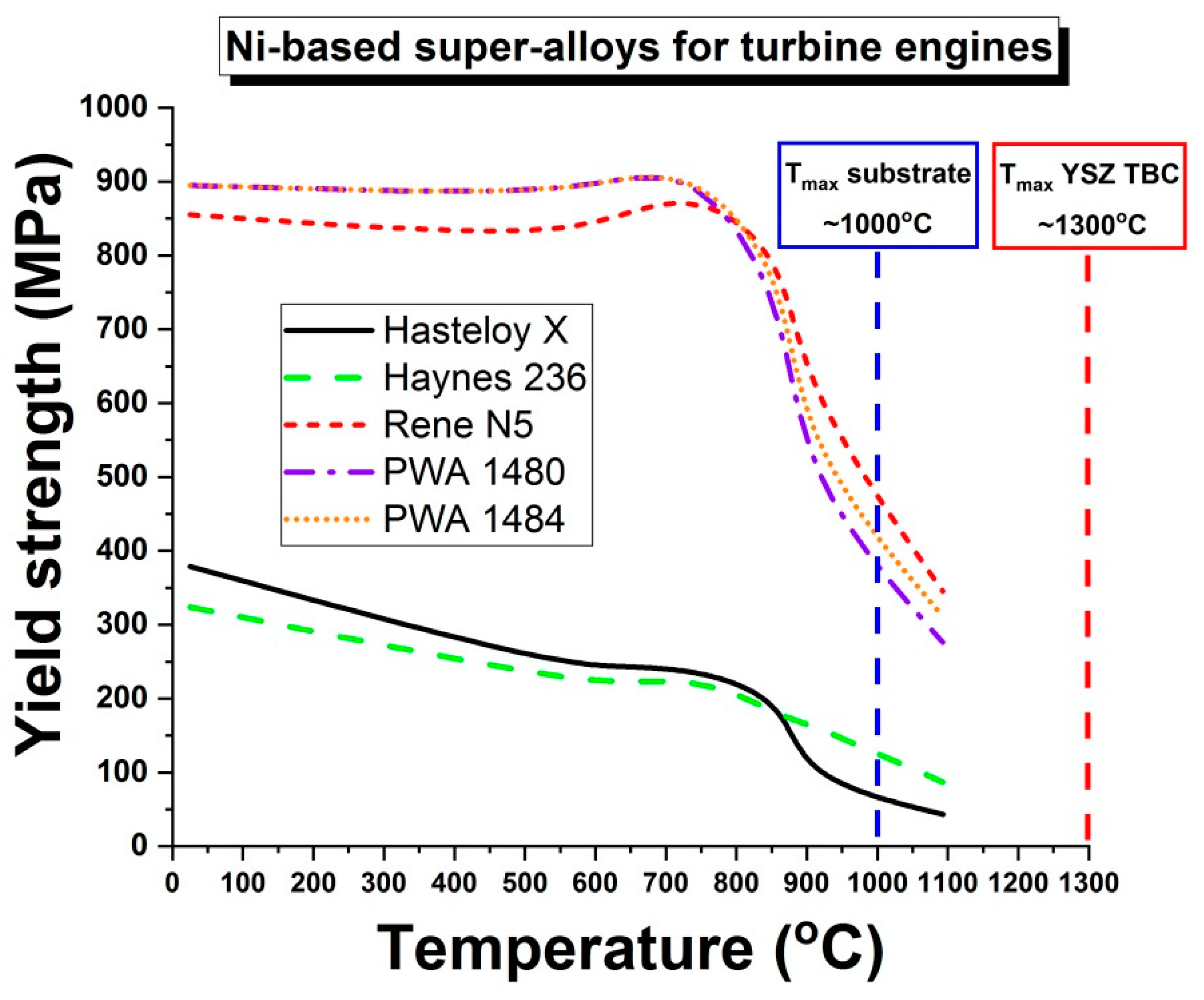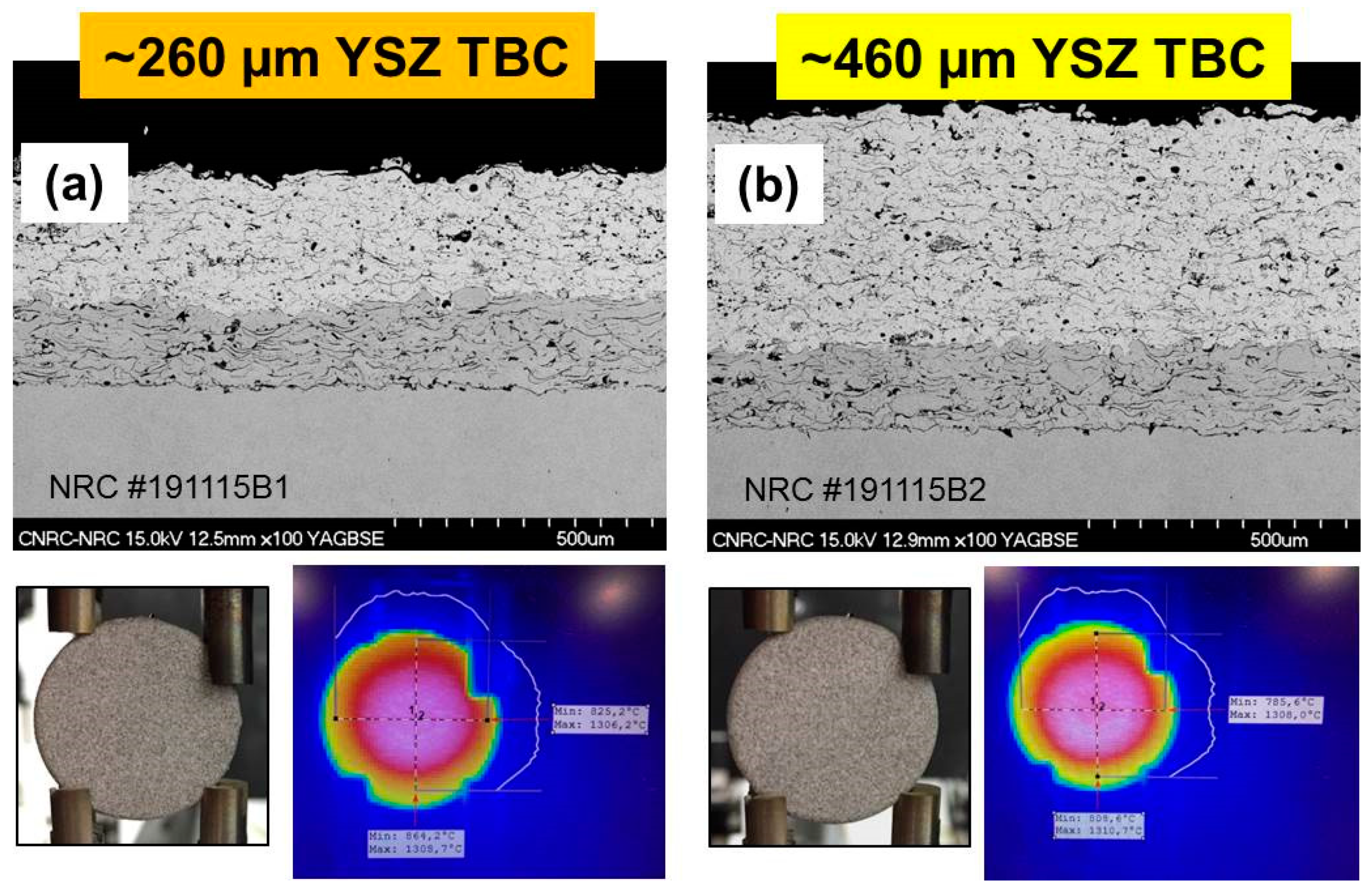Perspectives on Thermal Gradients in Porous ZrO2-7–8 wt.% Y2O3 (YSZ) Thermal Barrier Coatings (TBCs) Manufactured by Air Plasma Spray (APS)
Abstract
:1. Introduction
1.1. Overall Characterics of Porous APS YSZ TBCs
1.2. Maximum Operational Temperatures across APS YSZ TBC/Substrate Systems
1.3. Thermal Gradients across APS YSZ TBC/Substrate Systems
1.4. Rationale and Objectives
2. Materials and Methods
2.1. APS YSZ TBC Manufacturing and Properties
2.2. APS YSZ TBC Microstructure
2.3. Laser-Rig Thermal Gradient Testing
3. Results and Discussion
3.1. Porous APS YSZ TBC Microstructures and Laser-Rig Thermal Gradient Setup
3.2. Laser-Rig Thermal Gradient Testing
3.3. Porous APS YSZ TBC—Thermal Resistance
3.4. Understanding the Porous APS YSZ TBC Stability at High Temperatures
3.5. Thermal Gradient Values at Maximum T-ysz and T-sub Limits
3.6. Thermal Gradient Values for Porous APS YSZ TBCs Reported in the Literature
3.7. Final Remarks on Thermal Gradients
4. Conclusions
Funding
Acknowledgments
Conflicts of Interest
References
- Rolls-Royce. The Jet Engine. Available online: http://www.valentiniweb.com/Piermo/meccanica/mat/Rolls%20Royce%20-%20The%20Jet%20Engine.pdf (accessed on 20 July 2020).
- Farokhi, S. Aircraft Propulsion, 2nd ed.; John Wiley & Sons Ltd.: Chichester, West Sussex, UK, 2015; pp. 7–9, 483–488. [Google Scholar]
- Hardwicke, C.U.; Lau, Y.-C. Advances in Thermal Spray Coatings for Gas Turbines and Energy Generation: A Review. J. Therm. Spray Technol. 2013, 22, 564–576. [Google Scholar] [CrossRef]
- Padture, N.P. Thermal Barrier Coatings for Gas-Turbine Engine Applications. Science 2002, 296, 280–284. [Google Scholar] [CrossRef] [PubMed]
- Feuerstein, A.; Knapp, J.; Taylor, T.; Ashary, A.; Bolcavage, A.; Hitchman, N. Technical and Economical Aspects of Current Thermal Barrier Coating Systems for Gas Turbine Engines by Thermal Spray and EBPVD: A Review. J. Therm. Spray Technol. 2008, 17, 199–213. [Google Scholar] [CrossRef]
- Lima, R.S.; Guerreiro, B.M.H.; Curry, N.; Leitner, M.; Körner, K. Environmental, Economical, and Performance Impacts of Ar-H2 and N2-H2 Plasma-Sprayed YSZ TBCs. J. Therm. Spray Technol. 2019, 29, 74–89. [Google Scholar] [CrossRef]
- Smith, J.; Scheibel, J.; Classen, D.; Paschke, S.; Elbel, S.; Fick, K.; Carlson, D. Thermal Barrier Coating Validation Testing for Industrial Gas Turbine Combustion Hardware. J. Eng. Gas Turbines Power 2015, 138, 031508. [Google Scholar] [CrossRef]
- Kulkarni, A.; Wang, Z.; Nakamura, T.; Sampath, S.; Goland, A.; Herman, H.; Allen, J.; Ilavsky, J.; Long, G.; Frahm, J.; et al. Comprehensive microstructural characterization and predictive property modeling of plasma-sprayed zirconia coatings. Acta Mater. 2003, 51, 2457–2475. [Google Scholar] [CrossRef]
- Tan, Y.; Longtin, J.P.; Sampath, S.; Wang, H. Effect of the Starting Microstructure on the Thermal Properties of As-Sprayed and Thermally Exposed Plasma-Sprayed YSZ Coatings. J. Am. Ceram. Soc. 2009, 92, 710–716. [Google Scholar] [CrossRef]
- Helminiak, M.A.; Yanar, N.M.; Pettit, F.; Taylor, T.A.; Meier, G.H. Factors affecting the microstructural stability and durability of thermal barrier coatings fabricated by air plasma spraying. Mater. Corros. 2012, 63, 929–939. [Google Scholar] [CrossRef]
- Smialek, J.L.; Miller, R.A. Revisiting the birth of 7YSZ thermal barrier coatings: Stephan Stecura. Coatings 2018, 8, 255. [Google Scholar] [CrossRef] [Green Version]
- Clarke, D.R.; Oechsner, M.; Padture, N.P. Thermal-barrier coatings for more efficient gas-turbine engines. MRS Bull. 2012, 37, 891–898. [Google Scholar] [CrossRef] [Green Version]
- Borom, M.P.; Johnson, C.A.; Peluso, L.A. Role of environmental deposits and operating surface temperature in spallation of air plasma sprayed thermal barrier coatings. Surf. Coat. Technol. 1996, 86–87, 116–126. [Google Scholar] [CrossRef]
- Morelli, S.; Testa, V.; Bolelli, G.; Ligabue, O.; Molinari, E.; Antolotti, N.; Lusvarghi, L. CMAS corrosion of YSZ thermal barrier coatings obtained by different thermal spray processes. J. Eur. Ceram. Soc. 2020, 40, 4084–4100. [Google Scholar] [CrossRef]
- Brandon, J.; Taylor, R. Phase stability of zirconia-based thermal barrier coatings part I. Zirconia-yttria alloys. Surf. Coat. Technol. 1991, 46, 75–90. [Google Scholar] [CrossRef]
- Thompson, J.; Clyne, T. The effect of heat treatment on the stiffness of zirconia top coats in plasma-sprayed TBCs. Acta Mater. 2001, 49, 1565–1575. [Google Scholar] [CrossRef]
- High-Temperature High-Strength Nickel Base Alloys. Available online: https://www.stainless-steel-world.net/pdf/393.pdf (accessed on 28 June 2020).
- Perepezko, J.H. The Hotter the Engine, the Better. Science 2009, 326, 1068–1069. [Google Scholar] [CrossRef]
- Academies of Sciences, Engineering, and Medicine—Commercial Aircraft Propulsion and Energy Systems Research: Reducing Global Carbon Emissions. Available online: https://www.nap.edu/catalog/23490/commercial-aircraft-propulsion-and-energy-systems-research-reducing-global-carbon (accessed on 20 July 2020).
- Federal Aviation Administration—Advisory Circular—Subject: Ratings and Operating Limitations FOR Turbine Engines (SECTIONS 33.7 and 33.8). Available online: https://www.faa.gov/documentLibrary/media/Advisory_Circular/AC%2033-7.1.pdf (accessed on 20 July 2020).
- Mom, A.; Hersbach, H. Performance of high temperature coatings on F100 turbine blades under simulated service conditions. Mater. Sci. Eng. 1987, 87, 361–367. [Google Scholar] [CrossRef]
- Nelson, W.A.; Orenstein, R.M. TBC experience in land- based gas turbines. J. Therm. Spray Technol. 1997, 6, 176–180. [Google Scholar] [CrossRef] [Green Version]
- Zhu, D.; Miller, R.A. Thermal Conductivity and Elastic Modulus Evolution of Thermal Barrier Coatings under High Heat Flux Conditions. J. Therm. Spray Technol. 2000, 9, 175–180. [Google Scholar] [CrossRef]
- Aircraft Turbine Engine Combustion Section Inspection. Available online: https://www.aircraftsystemstech.com/2017/05/combustion-section-inspection.html (accessed on 26 July 2020).
- Why Your Engine Needs a Hot Section Inspection. Available online: https://www.pwc.ca/en/airtime-blog/articles/technical-tips/why-your-engine-needs-a-hot-section-inspection (accessed on 26 July 2020).
- Rangaswany, S.; Herman, H.; Safai, S. Thermal expansion study on plasma-sprayed oxide coatings. Thin Solid Films 1980, 73, 43–52. [Google Scholar] [CrossRef]
- Yanar, N.M.; Helminiak, M.; Meier, G.H.; Pettit, F. Comparison of the Failures during Cyclic Oxidation of Yttria-Stabilized (7 to 8 Weight Percent) Zirconia Thermal Barrier Coatings Fabricated via Electron Beam Physical Vapor Deposition and Air Plasma Spray. Met. Mater. Trans. A 2010, 42, 905–921. [Google Scholar] [CrossRef] [Green Version]
- Xie, L.; Dorfman, M.; Cipitria, A.; Paul, S.; Golosnoy, I.; Clyne, T. Properties and Performance of High-Purity Thermal Barrier Coatings. J. Therm. Spray Technol. 2007, 16, 804–808. [Google Scholar] [CrossRef] [Green Version]
- Standard powder certificate provided by manufacturer together with powder batch, Treibacher Industrie AG—Certificate of Analysis—AuerCoat YSZ LD Grade B–lot #170901-B–13 September 2018.
- Material Product Data Sheet—8% Yttria Stabilized Zirconia Agglomerated and HOSP Powders. Available online: https://www.oerlikon.com/ecomaXL/files/metco/oerlikon_DSM-0242.3_8YO_ZrO_HOSP.pdf&download=1 (accessed on 26 July 2020).
- Vaßen, R.; Traeger, F.; Stöver, D. Correlation Between Spraying Conditions and Microcrack Density and Their Influence on Thermal Cycling Life of Thermal Barrier Coatings. J. Therm. Spray Technol. 2004, 13, 396–404. [Google Scholar] [CrossRef]
- Tan, Y.; Longtin, J.P.; Sampath, S.; Zhu, D. Temperature-Gradient Effects in Thermal Barrier Coatings: An Investigation Through Modeling, High Heat Flux Test, and Embedded Sensor. J. Am. Ceram. Soc. 2010, 93, 3418–3426. [Google Scholar] [CrossRef]
- Vaßen, R.; Kerkhoff, G.; Stöver, D. Development of a micromechanical life prediction model for plasma sprayed thermal barrier coatings. Mater. Sci. Eng. A 2001, 303, 100–109. [Google Scholar] [CrossRef]
- Karger, M.; Vaßen, R.; Stöver, D. Atmospheric plasma sprayed thermal barrier coatings with high segmentation crack densities: Spraying process, microstructure and thermal cycling behavior. Surf. Coat. Technol. 2011, 206, 16–23. [Google Scholar] [CrossRef]









| YSZ Feedstock | ZrO2 | Y2O3 wt.% | SiO2 wt.% (Max) | TiO2 wt.% (Max) | Al2O3 wt.% (Max) | Fe2O3 wt.% (Max) |
|---|---|---|---|---|---|---|
| AuerCoat YSZ LD-B [29] | Balance | 7.6 | 0.01 | 0.05 | 0.0005 | 0.0005 |
| 204B-NS [30] | Balance | 7−8 | 0.3 | 0.2 | 0.2 | 0.2 |
| YSZ TBC Thickness (µm) | Porosity (%) | TC (W/mK) | T-ysz (°C) | T-bc (°C) calculated | T-sub (°C) | ΔTYSZ-SUB (°C) T-ysz−T-sub | ΔTYSZ (°C) T-ysz−TBC | YSZ Gradient (°C/µm) |
|---|---|---|---|---|---|---|---|---|
| ~260 | ~15 1 | ~0.80 1 | ~1310 | ~1075 | ~1030 | ~280 | ~235 | ~0.90 |
| ~460 | ~15 1 | ~0.80 1 | ~1305 | ~895 | ~840 | ~465 | ~410 | ~0.90 |
| Material | Substrate Shape Dimensions | BC Thick (µm) | YSZ Thick (µm) | YSZ Porosity (%) | Thermal Gradient Source | T-ysz (°C) | T-bc (°C) | T-sub (°C) | YSZ Gradient (°C/µm) | Ref. |
|---|---|---|---|---|---|---|---|---|---|---|
| Inconel 738 | Puck-shaped diam: 30 mm thick: 3.0 mm | ~150 | ~290 | ~12% | Burner-rig | ~1333 | ~1067 | ~1022 2 | ~0.92 | Vaßen et al. [31] |
| Inconel 738 | Puck-shaped diam: 30 mm thick: 3.0 mm | ~150 | ~260 | ~12% | Burner-rig | ~1322 | ~1047 | ~1002 2 | ~1.06 | Vaßen et al. [31] |
| Inconel 738 | Puck-shaped diam: 30 mm thick: 3.0 mm | ~150 | ~320 | ~12% | Burner-rig | ~1333 | ~1064 | ~1019 2 | ~0.84 | Vaßen et al. [31] |
| Inconel 738 | Puck-shaped diam: 30 mm thick: 3.0 mm | ~150 | ~260 | ~12% | Burner-rig | ~1326 | ~1074 | ~1029 2 | ~0.97 | Vaßen et al. [31] |
| Hastelloy X | Puck-shaped diam: 25.4 mm thick: 3.2 mm | ~64 | ~560 | n.a. 1 | Laser-rig | ~1140 | ~900 | ~840 | ~0.43 | Tan et al. [32] |
| Inconel 738 | Puck-shaped diam: 30 mm thick: 3.0 mm | ~150 | ~300 | ~12% | Burner-rig | ~1280 | ~1045 2 | ~1000 | ~0.78 | Vaßen et al. [33] |
| Inconel 738 | Puck-shaped diam: 25 mm thick: 3.0 mm | ~150 | ~450 | ~15% | Burner-rig | ~1269 | ~1070 | ~1045 | ~0.50 | Karger et al. [34] |
© 2020 by the author. Licensee MDPI, Basel, Switzerland. This article is an open access article distributed under the terms and conditions of the Creative Commons Attribution (CC BY) license (http://creativecommons.org/licenses/by/4.0/).
Share and Cite
Lima, R.S. Perspectives on Thermal Gradients in Porous ZrO2-7–8 wt.% Y2O3 (YSZ) Thermal Barrier Coatings (TBCs) Manufactured by Air Plasma Spray (APS). Coatings 2020, 10, 812. https://doi.org/10.3390/coatings10090812
Lima RS. Perspectives on Thermal Gradients in Porous ZrO2-7–8 wt.% Y2O3 (YSZ) Thermal Barrier Coatings (TBCs) Manufactured by Air Plasma Spray (APS). Coatings. 2020; 10(9):812. https://doi.org/10.3390/coatings10090812
Chicago/Turabian StyleLima, Rogerio S. 2020. "Perspectives on Thermal Gradients in Porous ZrO2-7–8 wt.% Y2O3 (YSZ) Thermal Barrier Coatings (TBCs) Manufactured by Air Plasma Spray (APS)" Coatings 10, no. 9: 812. https://doi.org/10.3390/coatings10090812
APA StyleLima, R. S. (2020). Perspectives on Thermal Gradients in Porous ZrO2-7–8 wt.% Y2O3 (YSZ) Thermal Barrier Coatings (TBCs) Manufactured by Air Plasma Spray (APS). Coatings, 10(9), 812. https://doi.org/10.3390/coatings10090812




